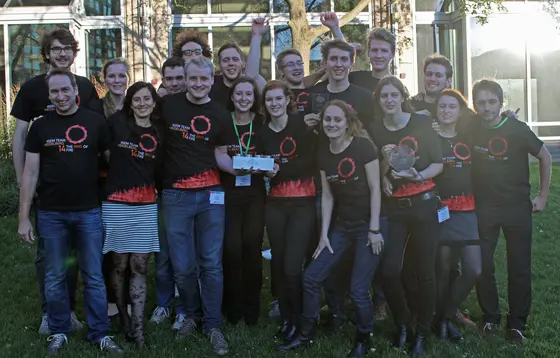With the project “Ring of Fire", the team of Heidelberg students solved a common problem in the use of biological molecules: Proteins are often not very stable, limiting their use in research and biotechnology projects.
The Heidelberg students got around this with a trick: They used a new method to cause proteins to form rings, which protects their fragile ends and makes them significantly more stable. This makes them suitable for potential new technological applications. This year’s team profited from the experience of their supervisors, Prof. Roland Eils (DKFZ and Heidelberg University) and Dr. Barbara Di Ventura (University of Heidelberg), who guided the winning team last year.
The venue was the international Genetically Engineered Machine (iGEM) contest in Boston, Massachusetts, and the Heidelberg team consisted of 12 bachelor and masters degree students. iGEM is an international competition in which student teams around the world use strategies from synthetic biology to search for solutions to stubborn yet often common problems. Synthetic biology in an up-and-coming research field in which scientists use genetic engineering methods to alter the properties of microorganisms in pursuit of advances in biomedicine, biotechnology or environmental research.
It was the final contest of this tenth iGEM jamboree in 2014, when the announcement was made: in the undergraduate category the Heidelberg team won first prize, beating out 244 other teams from 32 countries, outperforming even highly renowned universities such as Harvard, Yale and Stanford. Even the Grand Prize wasn’t enough: the Heidelberg team took home several special prizes, including two for best technological advance and best supporting software. And add to that their election as audience favorite.
Following the great success of last year’s team, the first from,Germany to win the iGEM championship, the Heidelberg team has yet another first: they have won iGEM twice in a row. Running up second and third were the Imperial College London (UK) and the NCTU Formosa (Taiwan).
Proteins are used in many applications in research, medicine and biotechnology. A great disadvantage is, however, that they are not very stable. Particularly the ends of a protein are very fragile. The students have now invented a method to protect these ends: They added so-called “linkers" to the protein, which is entangled like a thread of wool. Like additional pieces of thread, these linkers join the two ends to form a circle. The resulting circular proteins exhibit significantly higher stability than proteins with loose ends and thus lend themselves for use in new applications.
As an example, the Heidelberg team tested an application where a circular protein delivers significantly improved research results: Biomedical labs often amplify DNA using a method called polymerase chain reaction (PCR), which is performed at very high temperatures. During the amplification process, epigenetic characteristics of the DNA are lost, because the enzyme methyltransferase (DNMT1), which copies these chemical tags, does not tolerate the heat. This might now be helped by using a circular, heat-stable methyltransferase that amplifies not only the four letters that make up the genetic code but also the epigenetic DNA tags that are crucial for how the code is read and that regulate the activity of whole genes.
The students think that circularization can protect therapeutic proteins from degradation by body cells or stabilize enzymes that are used in food technology.
The Heidelberg students provided the science community with a universally applicable, standardized “toolbox" for the circularization of proteins. For this achievement, they additionally won the special prize for best technological advance.
In addition, the students programmed two new software applications for calculating the exact length of the linker that is needed for joining the two protein ends without interfering with its structure and function. As these applications use an immense amount of computer capacity, the team also developed a platform called “iGEM@Home" that can use capacity of idle computers worldwide for data processing. These advances in software development earned them another special prize.
The Heidelberg iGEM team was supported by the Klaus Tschira Foundation, the Dietmar Hopp Foundation, the Helmholtz Initiative “Synthetic Biology", the Excellence Cluster “CellNetworks" of Heidelberg University and others.
